service Oldsmobile Cutlass Supreme 1995 Owner's Manuals
[x] Cancel search | Manufacturer: OLDSMOBILE, Model Year: 1995, Model line: Cutlass Supreme, Model: Oldsmobile Cutlass Supreme 1995Pages: 340, PDF Size: 16.68 MB
Page 3 of 340
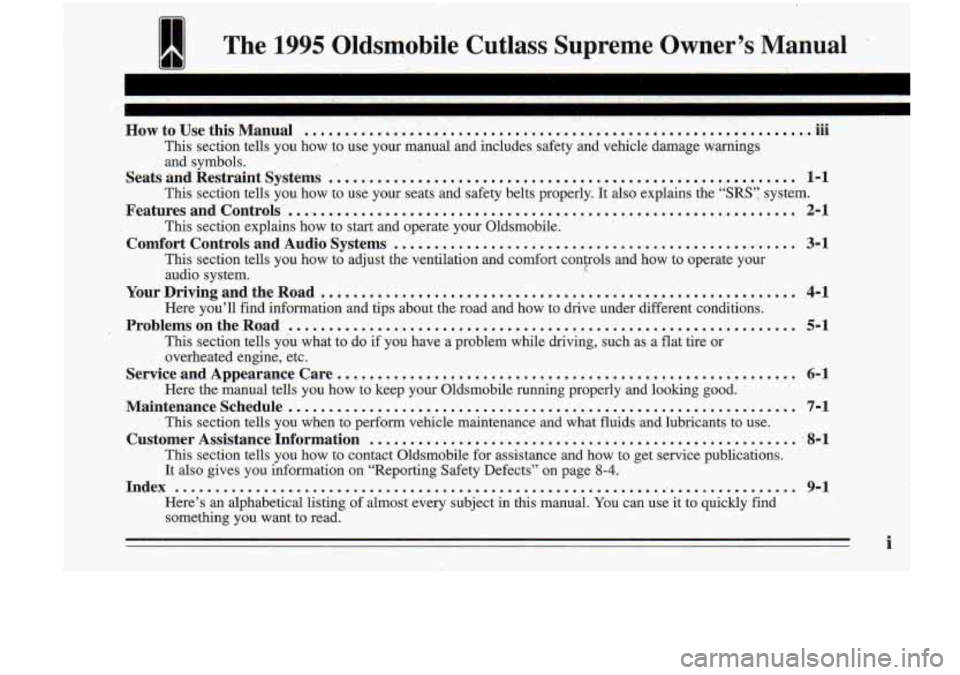
I The 1995 Oldsmobile Cutlass Supreme! Owner’s Manual
... How to Use this Manual ..................................... :.. ........................ .~II
This section tells you how to use your manual and includes sa\
fety and vehicle damage warnings and symbols.
This section tells you how to, use your seats and safety belt\
s properly. It also explains the “SRS’;.system.
Seats and Restraint Systems ........................................................... 1-1
Features and Controls ................................................................
This section explains how to start and operate .your Oldsmobile.
Comfort Controls and Audio Systems ..................................................
This’section tells you how to adjust the ‘ventilation and \
comfort conpols and how to operate your
audio system.
YourDrivingandtheRoad ...........................................................
Here you’ll find information and tips about the road and ho\
w to drive under different conditions.
ProblemsontheRoad ...............................................................
This section tells you what .to do if you have a problem while driving, such as a flat tire or
overheated engine, etc.
Here the manual tells you how to keep your Oldsmobile running \
properly and looking good.
This section tells you when to perform vehicle maintenance and what \
fluids and lubricants to use.
This section tells you how to contact Oldsmobile for assistance\
and how
to get service publications.
It also gives you infomation on “Reporting Safety Defects” on page
8-4.
Here’s an alphabetical listing of almost every subject in th\
is manual. You can use it to quickly find
something you want to read.
Service.and Appearance Care ..........................................................
Maintenanceschedule... ............................................................
Customer Assistance Information .....................................................
Index ........................................................................\
......
2-1
3- 1
4-1
5-1
6- 1
7-1
8-1
9-1
Page 4 of 340
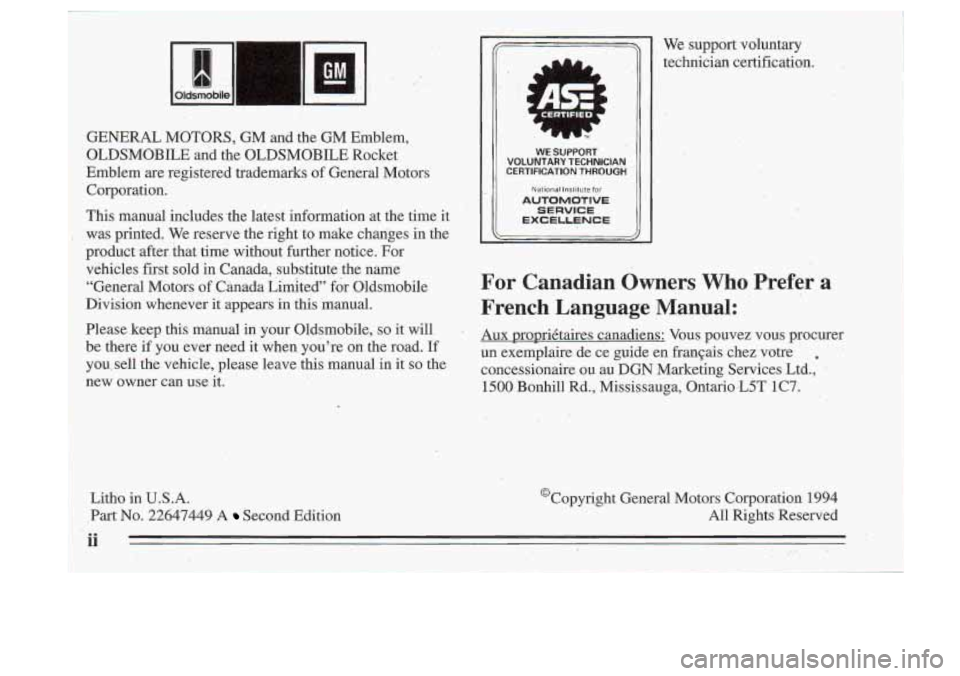
GENERAL MOTORS, GM'and the GM Emblem,
OLDSMOBILE and the OLDSMOBILE Rocket
Emblem are
registered trademarks of General Mators
Corporation.
This manual includes the latest information at the time it
was printed. We reserve the right to make changes in the
product after, that time without further notice. For
vehicles
first sold in Canada, substitute the name
"General Motors of Canada Limked" for Oldsmobile
Division whenever it appears in this manual.
Please keep this manual in your Oldsmobile,
so it will
be there if you ever need it when you're
on the road. If
you,sell the vehicle, please leave this manual in it so the
new owner can useit.
Litho
in U.S.A.
Part No. 22647449 A Second Edition
L
I
WE SUPPORT VOLUNTARY TECHNICIAN CERTIFICATION THROUGH
AUTOMOTIVE
National Institute for
SERVICE EXCELLENCE
We support voluntary
technician certification.
*! .. .*.
For Canadian Owners Who Prefer a
French Language Manual:
Aux propridtaires canadiens: Vous pouvez vous procurer
un exemplaire de ce guide en fransais chez votre
.
concessionaire ou au DGN Marketing Services Ltd.,
1500 Bonhill Rd., Mississauga, Ontario -L5T 1C7.
,
'Copyright General Motors Corporation 1994
All Rights Reserved
Page 31 of 340
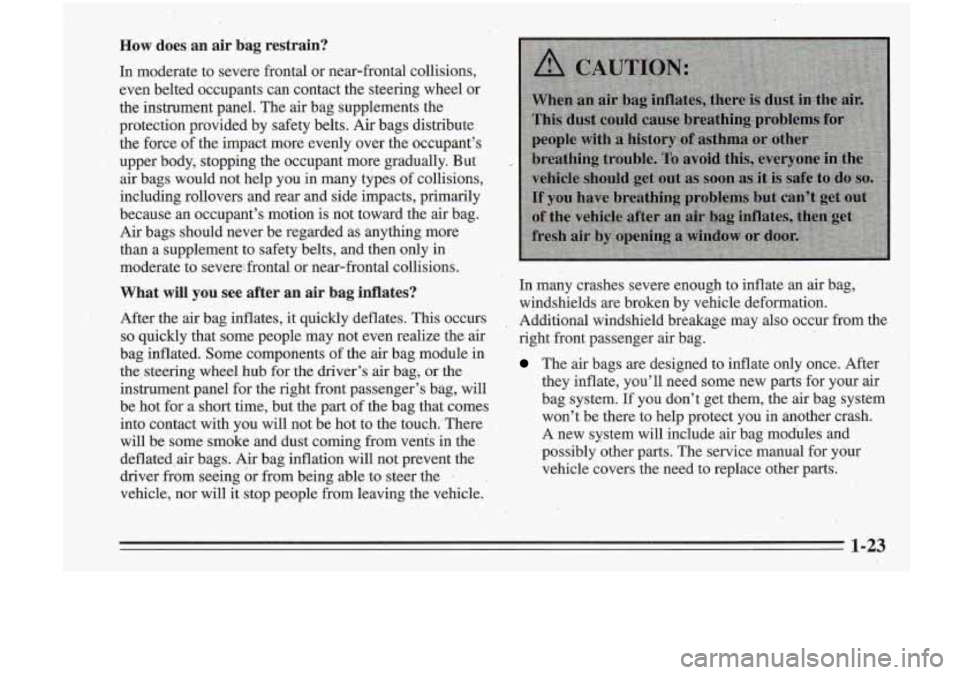
How does an air bag restrain? .*-=
In moderate to severe frontal or near-frontal collisions,
even belted occupants can contact the steering wheel or
the instrument panel. The air bag supplements the.
protection provided by safety belts. Air bags distribute.
the force of the impact more evenly over the occupant’s
upper body, stopping the occupant more gradually. But,
air bags would not help you in many types of collisions,
including rollovers and rear and side impacts, primarily
because an occupant’s motion is not toward the
air bag.
Air bags should never be regarded as anything more
than a supplement to safety belts, and then only in
moderate to severe: frontal or near-fmptal collisions.
What will you see after an air bag inflates?.
After .the air bag inflates, it quickly- deflates. This occurs
so quickly that some people may not even realize the air
bag inflated. Some components
of the air bag module in
the steering whekl hub for the driver’s
air bag, or the
instrument panel for the right front passenger’s bag, will
be hot for a short time,. but the part of the bag that comes
into contact with you will not be hot to the touch.’ There
will be some smoke and dust coming fromvents in the
deflated>air bags.
Air bag inflation will not. prevent the
driver from seeing or from being able to steer the
-
vehicle, nor will it stop people from leaving the vehicle.
,. In many crashes severe enough to inflate an air bag,
windshields are broken by vehicle deformation.
right--front passenger
air bag.
I Additional windshield breakage may also occur from the , . ..
The air bags are designed to inflate only once. AfteT
they inflate, you’ll need some new parts for your air
bag system.
If you don’t get them, the air bag syskm
won’t be there to help protect you in another crash.
A new system will include air bag modbles and
possibly other parts. The service manual for your
vehicle c,overs the need to replace other parts.
Page 32 of 340
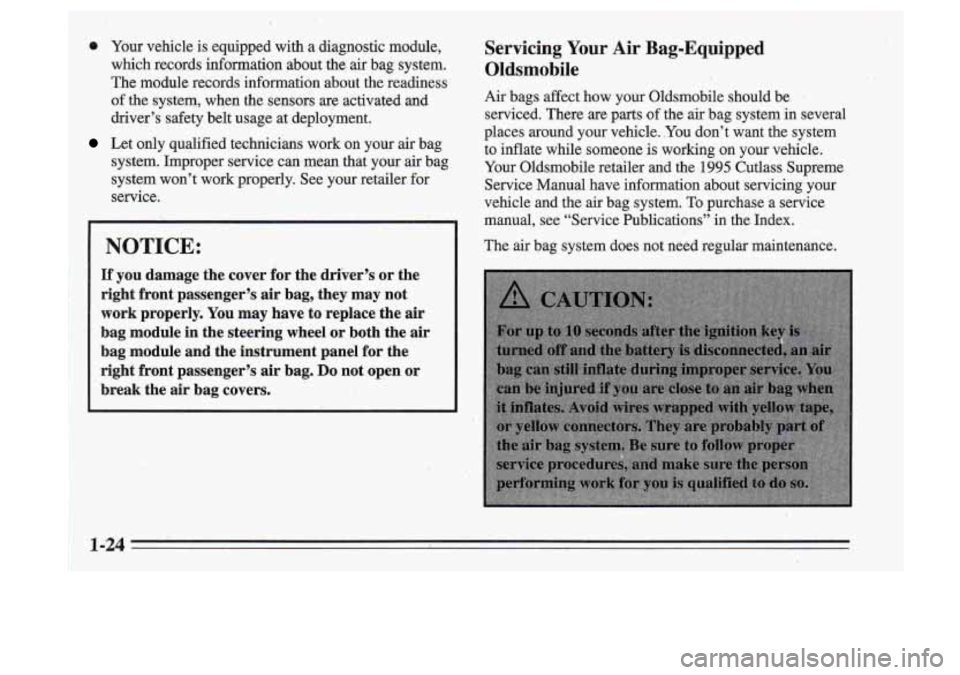
0 Your vehicle is equipped with a diagnostic module,
which records information about -the air bag system.
The module records information about the readiness
of
the system, when the sensors are activated and
driver’s safety belt usage at deployment.
Let only qualified technicians work on your air bag
system. Improper service can mean that your air bag
system won’t work properly. See your retailer for
service.
NOTICE:
If you damage the cover for the driver’s or the
right front passenger’s air bag, they may not
work properly. You may have to replace the
air
bag module in the steering wheel or both the air
bag module and the instrument panel fop the
right front passenger’s
air bag. Do not open or
break the air bag covers.
Servicing Your Air Bag-Equipped
Oldsmobile
Air bags affect how your Oldsmobile should be ..
serviced. There are parts of the air bag system in several
places around your vehicle. ,You don’t want the system
to inflate while someone is working on your vehicle.
Your Oldsmobile retailer and the
1995 Cutlass Supreme
Service Manual have infomation about servicing. your
vehicle and the air bag system. To purchase a service
manual, see “Service Publications” in the Index.
The air bag system does not need regular maintenance.
Page 63 of 340
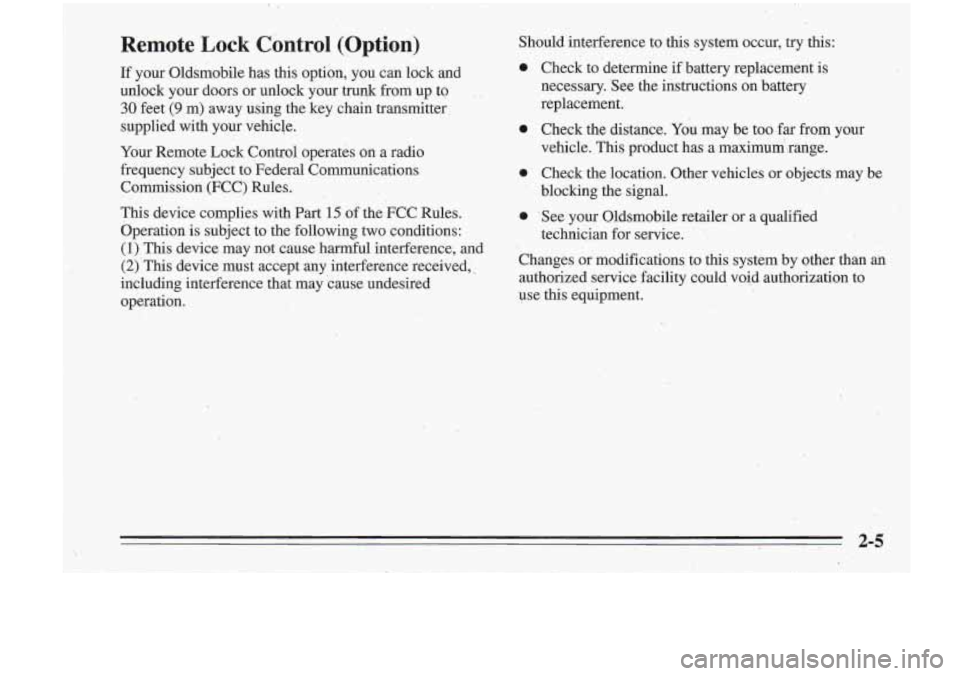
Remote Lock Control (Option)
If your Oldsmobile has this option, you can lock and
unlock your doors or unlock your
truqk from up to
30 feet (9 m) away using the key chain transmitter
supplied with
your vehicle.
Your Remote Lock Control operates on a radio
frequency subject to Federal Cornmanications
Commission (FCC) Rules.
This device complies with
Part 15 of the FCC Rules.
Operation is subject to
the following two conditions:
(1) This device may not cause harmful interference, and
(2) This device must accept any interferenc'e received,,
including interference that, may cause undesired
operation. Should
interference to this system occur, try this:
Check to -determine
if battery replacement is
necessary. 'See the instructions on battery
replacement.
Check the distance.
You may be too -far from your
vehicle.
This product has a maximummnge.
Check the location. Other vehicles or objects mav be
blocking the signal.
See your Oldsmobile retailer or
a qualified
technician for service.
Changes or modifications
to this system by other than an
authorized service facility could void authorization to
use this equipment.
2-5
Page 68 of 340
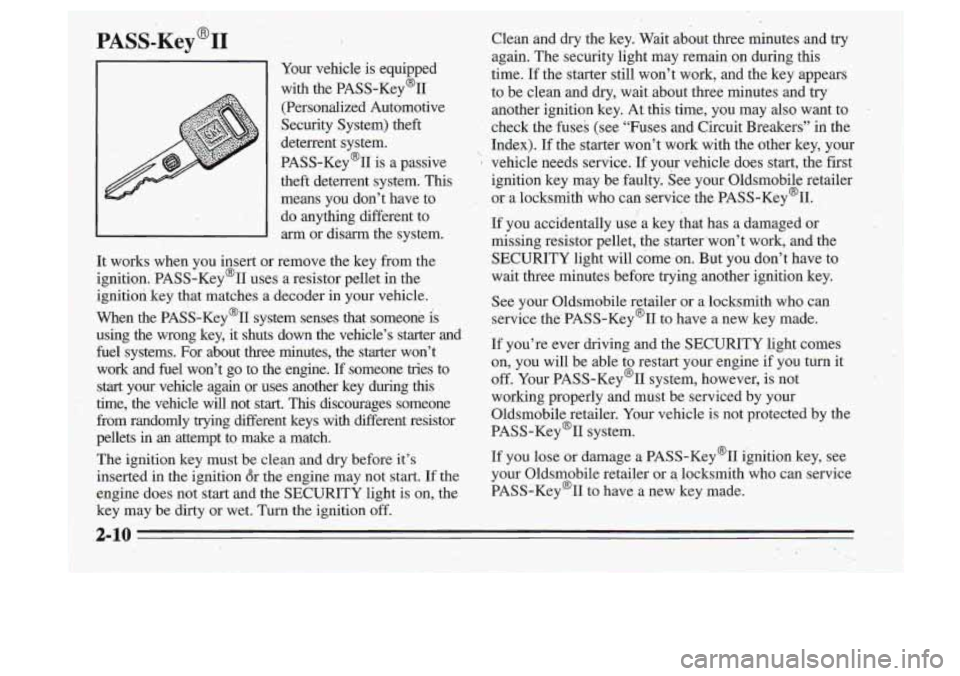
PASS-Key@II
r
J
Your vehicle is equipped
with the PASS-Key’II (Personalized Automotive
Security System) -theft
deterrent system.
PASS-Key’II is a passive
theft deterrent system. This
means you don’t have to
do anything different to
arm or disarm the system.
It works when you insert or remove the key from the
ignition. PASS-Key’II uses a resistor pellet in the
ignition key that matches a decoder in your vehicle.
When the PASS-Key@II system senses that someone
is
using the wrong key, it shuts down the vehicle’s starter an\
d
fuel systems. For about three minutes,
.the starter won’t
work and fuel won’t go to the engine. If someone tries
to
start your vehicle again Or uses another key during this
time, the vehicle will not
start. This discourages someone
from randomly trying different keys with different resistor
pellets in
an attempt to make a match.
The ignition key must be clean and dry before it’s
inserted in the ignition dr the- engine may not start. If the
engine does not start and the SECURITY light is on, the
key may be dirty or wet. Turn the ignition off. Clean and dry the key. Wait about three minutes and try
again. The security light may remain on during this
time. If the starter still won’t work, and the key appears
to be clean and dry, wait about three minutes and try
another ignition key. At this time, you may also want to
check the fuses (see “Fuses and Circuit Breakers” in the\
Index). If the starter won’t work with the other key, your
q vehicle needs service. If your vehicle does start, the first
ignition key may be faulty. See your Oldsmobile retailer
or a locksmith who can service the PASS-Key’II.
If you accidentally use a key that has a damaged or
missing resistor pellet, the starter‘won’t work, and the SECURITY light will come on. But you don’t have to
wait three minutes before trying another ignition key.
See your Oldsmobile retailer or a locksmith who can
service the PASS-Key@II
to have a new key made.
If you’re ever driving and the SECURITY light comes
on, you will be able to restart your engine if you turn it
off. Your PASS-Key’II system, however, is not
working properly and must be serviced by your
Oldsmobile retailer. Your vehicle is not protected by the
PASS-Key@II system.
If you lose or damage a PASS-Key@II ignition key, see
your Oldsmobile retailer or a, locksmith who can service
PASS-Key@II to have a new key made.
2-10
.. .
Page 75 of 340

DRIVE (D): This position is for normal driving. It is the
Overdrive position. If you need more power for passing,
and you’re:
- Going less than 35 mph (56 M), push your
accelerator pedal about halfway down.
- Going about 35 mph (56 kmh) or more, push the
accelerator pedal all the way down.
You’ll shift down to the next gear and have more
power.
NOTICE:
If your vehicle seems tb start up rather slowly, or
if it seems not to
shift gears as you go faster,
something
may be wrong with a transaxle system
sensor.
If you drive very far that way, your
vehicle can be damaged.
So, if this happens, have
your vehicle serviced right away. Until then, you
can use SECOND
(2) when you are driving less
than
35 mph (56 km/h) and DRIVE (D) for
higher speeds. THIRD
(3): THIRD (3) is like DRIVE (D),
but you
never
go into Overdrive.
Here are some times you might choose THIRD
(3)
instead of DRIVE (D):
- When driving on hilly, winding roads.
- When towing a trailer, so there is less shifting
- When going down a steep hill.
SECOND
(2): This position gives you more power but
lower fuel economy. You can use SECOND
(2) on hills.
It can help control your speed
as you go down steep
mountain roads, but then you would also want to use
between gears.
lr
brakes off and on.
NOTICE:
Don’t drive in SECOND (2) for more than
5 miles (8 km), or at speeds over 55 mph
(88 km/h), or you can damage your transaxle. Use
DRIVE
@) or THIRD (3) as much aspossible.
Don’t
shift into SECOND (2) unless you are going
slower than
65 mph (105 km/h), or you can
damage your engine.
Page 103 of 340
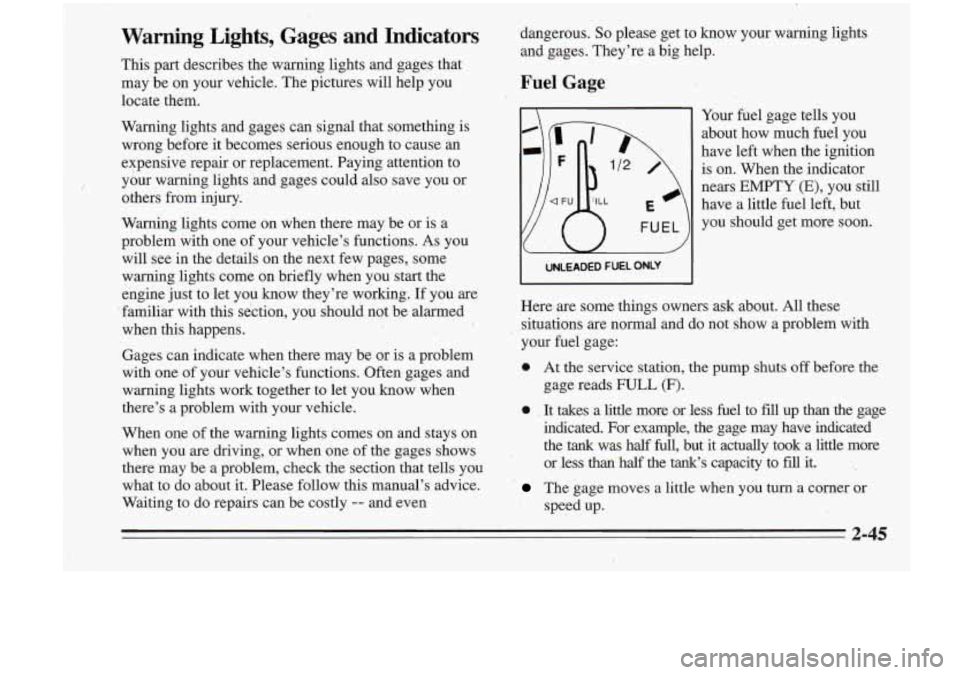
Warning Lights, Gages and Indicators
This part describes the warning lights and,gages that
may be
on your vehicle. The pictures will help you
locate them.
Warning lights and gages can signal that something
is
wrong before it becomFs serious enough to cause an
expensive repair or replacement. Paying attention to
your warning.lights and gages could also save you or
others from injury.
Warning lights come on when there may be or is a
problem with one of your vehicle’s functions.
As you
will see in the details on the next few pages, some
warning lights come on briefly when you start the
engine just to let you know they’re working.
If you are
‘familiar with this section, you should not be alarmed
when this happens.
Gages can indicate when there may be or is a problem
with one-of your vehicle’s functions. Often gages and
warning lights work together to let you know when
there’s a problem with your vehicle.
When one
of the warning lights comes on and stays on
when you are driving, or when one of the gages shows
there may be a problem, check the section that
tells you
what to do about
it. Please follow this manual’s advice.
Waiting to do repairs can be costly
-- and even dangerous.
So please
get to know your warning lights
and gages. They’re
a big help.
Fuel Gage
Your fuel gage tells you
about how much fuel
YOU
have left when the ignition
is on. When the indicator
nears
EMPTY (E), you still
have
a little fuel left, but
you should get more soon.
UNLEADED FUEL ONLY I
I
Here are some things owners ask about. All these
situations are normal and do not show a problem with
your fuel gage:
0 At the service station, the pump shuts off before the
gage reads
FULL (F).
0 . It takes a little more or less fuel to fill up than the gage
indicated. For example, the gage may have indicated
the
tank was half full, but it actually took a little more
or less
than half the tank‘s capacity to fill it.
The gage moves a little when you turn a corner or
speed up.
2-45
Page 105 of 340

Safety Belt Reminder Light
8 -10
When the’key is turned to
RUN or START, a chime
will come on for about eight
seconds to remind people to
fasten their safety belts,
unless the driver’s safety
belt is already buckled. The
safety belt light Will also
come on and stay on until
the driver’s belt is buckled.
Air Bag Readiness Light
There is an air bag readiness light on the instrument
panel, which shows
i?lIR BAG or shows the air bag
symbol. The system checks the air bag’s electrical
system for malfunctions. The light ‘tells you if there is an
electrical problem. The system check includes the air
bag sensors and modules, the wiring and the diagnostic
module. For more information on the air bag system, ,see
“Air Bag” in the Index.
’ You will see this light flash
for a few seconds when you
turn your ignition to RUN
or START. Then the light
should go out. This means
the system is ready.
If the air bag readiness light doesn’t come on when you
start your vehicle, or stays on, or comes on when you
are driving, your air bag system may not work properly.,
Have your vehicle serviced right away.
2-47
Page 106 of 340

Brake System Warning Light
Your Oldsmobile’s
hydraulic brake system is
divided into two parts. If
one part isn’t working, the
other
part can still work and
stop you. For good braking,
though, you need both parts
working well. If
the light comes on while you
are driving, pull off the
road and stop carefully. You may notice that the pedal is
harder to push. Or,
the pedal may go closer to the floor.
It may take longer to stop.
If the light is still on, or if the
anti-lock brake system warning light
is flashing, have
the vehicle towed for service. (See “Anti-Lock Brake
System Warning Light” and “Towing Your Vehicle” in
the Index.)
If the warning light comes on, there could be a brake
problem. Have your brake system inspected right away.
:This light should come on briefly as you start the
vehicle. If it doesn’t come on then, have it fixed
so it
mill be ready to warn you
if there’s a problem.
The brake.system warning light will also come on when
you set your parking brake,
and it will stayion if your
parking brake doesn’t release fully. If it stays on after
your parking brake is fuily released, it means you have a
brakerproblem.
2-48